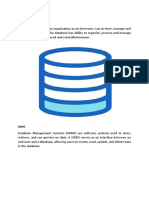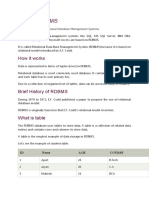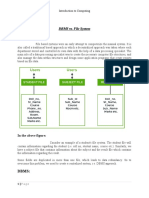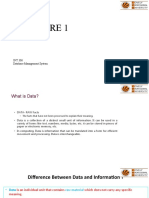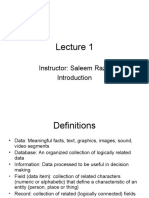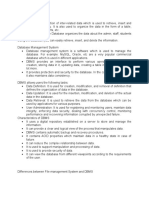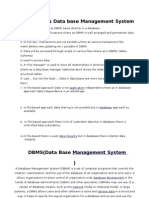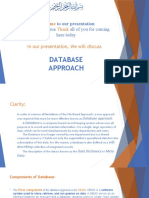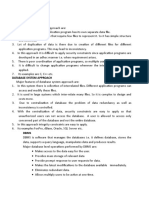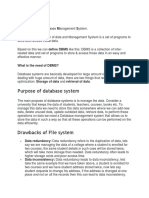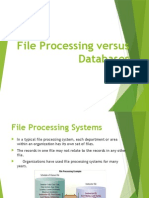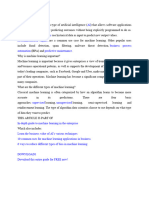0 ratings0% found this document useful (0 votes) 75 views6 pagesDifference Between Database and Manual Database
Copyright
© © All Rights Reserved
We take content rights seriously. If you suspect this is your content,
claim it here.
Available Formats
Download as PDF or read online on Scribd
There are the following differences between DBMS and
=ile systems:
Basis DBMS File
Approach System
Approach
Meaning DBMS is a collection |The file
of data. In DBMS,
j the user is not
system is a
collection of
required to write the | data. In this
| | procedures.
system, the
| user has to
| | write the
| | procedures for
| managing the
| database.
|
Sharing of Due to the | Data is
| data | centralized distributed in
| | approach, data many files,
_ sharing is easy. and it may be
of — different
formats, so it
isn't easy to
share data.
So . fe cl�Data
Abstraction
DBMS gives an_ The file
abstract view of system
data that hides the provides the
details. detail of the
data
representation
and storage of
data.
Security and
DBMS provides a_ It isn't easy to
Protection good protection protect a file
_ mechanism. “under the file
system.
Recovery DBMS provides a_ The file
Mechanism crash recovery system
mechanism, i.e., | doesn't have a
DBMS protects the | crash
user from system mechanism,
failure. ie, if the
system
crashes while
entering some
data, then the
content of the
file will be
lost.�Manipulation
Techniques
Concurrency
Problems
Where to use
|
| DBMS contains a The file
wide variety of system can't
sophisticated efficiently
techniques to store | store and
and retrieve the retrieve the
data. data.
DBMS takes care of In the File
Concurrent access | system,
of data using some | concurrent
form of locking. access has
many
problems like
redirecting the
file while
deleting some
information or
updating
some
information.
Database approach File system
used in large approach
systems which | used in large
interrelate many systems
files. which
interrelate
| many files.�Cost | The database
system is expensive
The file
system
Inconsistency problems of data
to design. approach is
| cheaper _ to
design.
Data | Due to the In this, the
Redundancy _ centralization of the | files and
and database, the | application
programs are
redundancy and | created by
inconsistency are different
controlled. programmers
so that there
exists a lot of
duplication of
data which
may lead to
inconsistency.
| Structure The database The file
| structure is complex | system
to design. approach has
| a simple
|
structure.�Data In this system, Data In the File
Independence | Independence system
exists, and it can be approach,
| of two types. there exists no
Data
2 Logical Data | Independence.
| Independence
© Physical Data |
Independence |
| = |
Integrity | Integrity Constraints | Integrity
| Constraints are easy to apply. Constraints
| | are difficult to
| implement in
| file system.
| _
| Data Models In the database In the file
| | approach, 3 types of system
| data models exist: approach,
|
there is no
| ° Hierarchal concept of
| el
data models data models
o Network data exists.
models
|
| o Relational
| data models�Flexibility
_ Examples
Oracle, SQL Server, |
| Sybase etc.
|
Changes are often a
necessity to the
content of the data
stored in any
system, and these
changes are more
easily with a
database approach.
The flexibility
of the system
is less as
compared to
the DBMS
approach.
Cobol, C++
etc.

